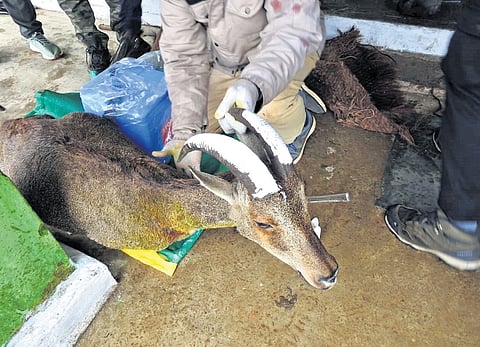

CHENNAI: The results of a first-of-its-kind successful quick capture and release operation of a Nilgiri Tahr, one of a few with a “football-size” inflammation on its body, has solved the years-long mystery worrying and puzzling forest officials and researchers working on the conservation of the Tamil Nadu state animal.
It was found that Coenurus cysts, an intermediate stage of Taenia tapeworms prevalent in the carnivore population, caused the tumour-like masses. Most importantly, the results showed these lumps are non-fatal for the animal, which comes as a huge relief as there was a suspicion that the lumps might be cancerous.
Chief Wildlife Warden Srinivas R Reddy told TNIE that wild carnivores host adult tapeworms in their intestines and their eggs come out through faeces. Herbivores, including Nilgiri Tahrs, accidentally ingest the eggs while grazing. The parasites, within these animals, develop into cysts which is a larval stage forming lumps in different locations, including the subcutaneous and intermuscular tissues.
The carnivores ingest the cysts along with the flesh of the tahrs during predation or scavenging, from where the larvae develop into a tapeworm, completing the life cycle. “There is no significant threat to the conservation of Nilgiri Tahrs. The number of infected individuals is limited, so no intervention is required, except for regular monitoring,” he said.
The findings come at a time when the “Project Nilgiri Tahr” team is consolidating the results of the recently conducted first-ever synchronised population census, which will be the baseline data for the long-term conservation and protection of the iconic species. Chief Minister M K Stalin is likely to release the census results in July, sources said.
Environment, Forests & Climate Change Department additional chief secretary Supriya Sahu said it was the first time Nilgiri Tahr was tranquilised and physically examined. “It was an important exercise and a relief to know that these lumps were not lethal as we have plans to introduce Tahr in some of the erstwhile habitats, where they had gone locally extinct.”
The capture-and-release operation was conducted on May 29, during which the officials collected samples for diagnosis. Project Nilgiri Tahr director M G Ganesan said a dedicated team, comprising officials from TANUVAS, WWF India and forest staff, was formed and a standard operating procedure was formulated. “On May 29 afternoon, a herd of Tahrs that were habituated with salt-licks came near a trekking hut in the Western Catchment of Mukurthi National Park.
Among the herd, was an adult female with a lump, which was caught with nets and immediately sedated. The operation was conducted smoothly and the animal was released back in an hour after collecting samples. The lump was surgically removed as well,” he said.
These lumps are noticed only in Tahrs suggesting they appear to be the natural intermediate hosts of the tapeworms. “We did not find it in other common ungulates like gaurs, sambar deer, spotted deer and barking deer that share the terrain. We need to carry out further studies to gain more insights,” Ganesan added.